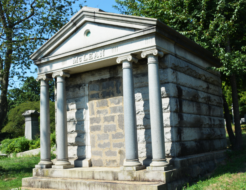Title: Army Assistant Surgeon, Civil War; physician
Birthdate: July, 1830
Death Date: February 3, 1907
Plot Location: Section 125, Lots 25-26

Hugh was the last child born in a large Irish family and was the only one born after the McLeans left their homeland and settled in Mauch Chunk, Pennsylvania in Carbon County. (The town was renamed Jim Thorpe in 1954.) His birth date varies by source; military documents show 1835, college records say 1832, but his death certificate fits better with census data placing his birth in 1830,
Hugh continued his schooling close to home when he entered Lafayette College in Easton, Pennsylvania in 1849. After his junior year he transferred to Jefferson Medical College in Philadelphia where he graduated in 1854.
The young doctor with a promising future would have made a fine catch as a husband, but he remained single for another 20 years. He set up his practice at 1315 Lombard Street until the drumbeats of war called him to serve. Hugh was commissioned Assistant Surgeon, Field and Staff, 106th Pennsylvania Volunteer Infantry on November 5, 1862.
His first introduction to a field hospital came at the Battle of Fredericksburg in December, followed by General Burnside’s “Mud March” and the Chancellorsville Campaign in the spring of 1863. At Gettysburg the 106th only lost nine of its 335 men, with 54 wounded.
Battlefield medicine had none of the amenities his big-city training afforded him. Although it was only the most basic of care, facilities remained at Gettysburg to treat the wounded for weeks after the battle was over. Dr. McLean did what he could, then followed the regiment to Virginia for the Bristoe campaign in October and at Mine Run in November. He was discharged by Special Order on December 5, 1863.
What that means is open to speculation. However, it wouldn’t be unreasonable to assume traumatic stress afflicted many physicians. The sheer volume of wounded, lack of supplies, plus the spread of disease, would be overwhelming. Health care workers often worked 48 hours at a time without having antiseptics, proper sterilization, and effective medications.
Hugh came back to Philly to resume his practice, moving to 1331 Pine Street. He lived there the rest of his life and it was probably his office as well. He became the husband of Mary Simpson on April 17, 1876 in a ceremony at Trenton, New Jersey. They never had children but Hugh was very close to his brother’s son, John, who would become a doctor himself.
The strangest fact about Hugh’s post-war life was he was never listed as head of a household in the census reports. He and his wife were simply boarders there. At his death, however, the appraisal of his estate listed 1313 Pine Street as just one of 44 residential properties that he actually owned.
Mary died in 1899, so she was added to the McLean mausoleum after it was built, after Hugh’s death eight years later. His personal estate totaled more than $11,000 but his real estate was worth $73,000. Most of it was divided among his nieces and nephews. 
His nephew, Dr. John D. McLean signed his death certificate and was one of the executors. He received all of his uncle’s surgical instruments and library. Hugh made two charitable donations designating that two homes for the aged should each receive $5000 to name a room after him.
The only other bequest was $1000 to Mount Moriah Cemetery, “to be held in trust and to be securely invested, and the net income thereof used solely every year in keeping my lot in said cemetery and the improvements thereon in good order and repair.” Unfortunately, Mount Moriah found, as many other cemeteries are now learning, that while “perpetual care” implies it lasts into eternity, the “perpetual care fund” will not.

Support the Friends of Mount Moriah
Help us in our mission to restore and maintain the beautiful Mount Moriah Cemetery by donating to our cause or volunteering at one of our clean-up events.

